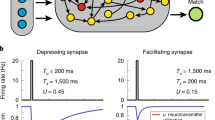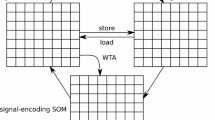Abstract
Neural network models of working memory, called “sustained temporal order recurrent” (STORE) models, are described. They encode the invariant temporal order of sequential events in short-term memory (STM) in a way that mimics cognitive data about working memory, including primacy, recency, and bowed order and error gradients. As new items are presented, the pattern of previously stored items remains invariant in the sense that relative activations remain constant through time. This invariant temporal order code enables all possible groupings of sequential events to be stably learned and remembered in real time, even as new events perturb the system. Such competence is needed to design self-organizing temporal recognition and planning systems in which any subsequence of events may need to be categorized in order to control and predict future behavior or external events. STORE models show how arbitrary event sequences may be invariantly stored, including repeated events. A preprocessor interacts with the working memory to represent event repeats in spatially separate locations. It is shown why at least two processing levels are needed to invariantly store events presented with variable durations and interstimulus intervals. It is also shown how network parameters control the type and shape of primacy, recency, or bowed temporal order gradients that will be stored.
Similar content being viewed by others
References
Atkinson RC, Shiffrin RM (1971) The control of short term memory. Sci Am, August:82–90
Baddeley AD (1986) Working memory. Clarendon Press, Oxford
Boardman I, Bullock D (1991) A neural network model of serial order recall from short-term memory. In: Proceedings of the international joint conference on neural networks, Seattle, II:879–884 IEEE Service Center, Piscataway, NJ
Boardman I, Cohen MA, Grossberg S (1993) Variable rate working memories for phonetic categorization and invariant speech perception. In: Proceedings of the international joint conference on neural networks, Portland, III:2–5. IEEE Service Center, Piscataway, NJ
Bradski G, Carpenter GA, Grossberg S (1991) Working memory networks for learning multiple groupings of temporally ordered events: applications to 3-D visual object recognition. In: Proceedings of the international joint conference on neural networks, Seattle, 1: 723–728. IEEE Service Center, Piscataway, NJ
Bradski G, Carpenter, GA, Grossberg, S (1992) Working memory networks for learning temporal order with application to 3-D visual object recognition. Neural Comp 4:270–286
Carpenter GA, Grossberg S (eds) (1991) Pattern recognition by self-organizing neural networks. MIT Press, Cambridge, MA
Carpenter GA, Grossberg S (1992) A self-organizing neural network for supervised learning, recognition, and prediction. IEEE Commun 30:38–49
Carpenter GA, Grossberg S, Reynolds JH (1991) ARTMAP: supervised real-time learning and classification of nonstationary data by a self-organizing neural network. Neural Networks 4:565–588
Carpenter GA, Grossberg S, Markuzon N, Reynolds JH, Rosen DB (1992) Fuzzy ARTMAP: a neural network architecture for incremental supervised learning of analog multidimensional maps. IEEE Trans Neural Networks 3:698–713
Cohen MA, Grossberg S (1986) Neural dynamics of speech and language coding: developmental programs, perceptual grouping, and competition for short term memory. Hum Neurobiol 5:1–22
Elman JL (1990) Finding structure in time. Cogn 14:179–211
Gaudiano P, Grossberg S (1991) Vector associative maps: unsupervised real-time error-based learning and control of movement trajectories. Neural Networks 4:147–183
Grossberg S (1970) Some networks that can learn, remember, and reproduce any number of complicated space-time patterns. II. Stud Appl Math 49:135–166
Grossberg S (1973) Contour enhancement, short term memory, and constancies in reverberating neural networks. Stud Appl Math 52:217–257
Grossberg S (1976) Adaptive pattern classification and universal recoding. I. Parallel development and coding of neural feature detectors. Biol Cybern 23:121–134
Grossberg S (1978a) A theory of human memory: self-organization and performance of sensory-motor codes, maps, and plans. In: Rosen R, Snell F (Eds) Progress in theoretical biology, Vol 5. Academic Press, New York, pp 233–374
Grossberg S (1987b) Behavioral contrast in short term memory: serial binary memory models or parallel continuous memory models? J Math Psychol 17:199–219
Grossberg S (1982) Studies of mind and brain: neural principles of learning, perception, development, cognition, and motor control. Reidel Press, Boston
Grossberg S (1986) The adaptive self-organization of serial order in behavior: speech, language, and motor control. Schwab EC, Nusbaum, HC (Eds) Pattern recognition by humans and machines, Vol 1. Speech perception. Academic Press, New York, pp 187–294. Reprinted in: Grossberg S (eds) The adaptive brain. II. Vision, Speech, language, and motor control. Elsevier/North-Holland, Amsterdam, pp 311–400
Grossberg S, Kuperstein M (1989) Neural dynamics of adaptive sensory-motor control: expanded edition. Pergamon Press, Elmsford, NY
Grossberg S, Pepe J (1971) Spiking threshold and overarousal effects in serial learning. J Stat Phys 3:95–125
Grossberg S, Stone GO (1986a) Neural dynamics of attention switching and temporal order information in short term memory. Memory Cogn 14:451–468
Grossberg S, Stone GO (1986b) Neural dynamics of word recognition and recall: attentional priming, learning, and resonance. Psychol Rev 93:46–74
Gutfreund H, Mezard M (1988) Processing of temporal sequences in neural networks. Physiol Rev Lett 61:235–238
Guyon I, Personnaz L, Nadal JP, Dreyfus G (1988) Storage retrieval of complex sequences in neural networks. Physiol Rev A 38:6365–6372
Healy AF (1975) Separating item from order information in short-term memory. J Verbal Learn Verbal Behav 13:644–655
Jordan MI (1986) Serial order: a parallel distributed processing approach. (Institute for Cognitive Science, Report 8604) University of California, San Diego
Lee C, Estes WK (1981) Item and order information in short-term memory: evidence for multilevel perturbation process J Exp Psychol Hum Learn Memory 1:149–169
Miller JL (1981) Effects of speaking rate on segmental distinctions In: Eimas PD, Miller JL (Eds) Perspectives on the study of speech. Lawrence Erlbaum, Hillsdale, NJ
Miller JL, Liberman AM (1979) Some effects of later-occurring information on the perception of stop consonant and semivowel. Percept Psychophys 25:457–465
Ratcliff, R (1978) A theory of memory retrieval. Psychol Rev 85:59–108
Reeves A, Sperling G (1986) Attention gating in short-term visual memory. Psychol Rev 93:180–206
Repp BH (1980) A range-frequency effect on perception of silence in speech. Haskins Laboratories Status Report on Speech Research, SR-61:151–165
Repp BH (1983) Bi directional contrast effects in the perception of VC-CV sequences. Percept Psychophys 33:147–155
Repp B, Liberman A, Eccardt T, Pestsky D (1978) Perceptual integration of acoustic cues for stop fricative and affiricate manner. J Exp Psychol Hum Percept Perform 4:621–637
Schreter Z, Pfeifer R (1989) Short-term memory/long-term memory interactions in connectionist simulations of psychological experiments on list learning. In: Personnaz L, Dreyfus G (Eds) Neural networks from models to applications. IDSET, Paris
Seibert MC (1991) Neural networks for machine vision: learning three-dimensional object recognition. PhD Dissertation, Boston University
Seibert MC, Waxman AM (1990a) Learning aspect graph representations from view sequences. In: Touretzky DS (Eds) Advances in neural information processing systems 2. Morgan Kaufmann, San Mateo, CA, pp 258–265
Seibert MC, Waxman AM (1990b) Learning aspect graph representations of 3D objects in a neural network. In: Caudill M (eds) Proceedings of the international joint conference on neural networks, Washington, DC, 2. Lawrence Erlbaum, Hillsdale, NJ, 233–236
Tartter VC, Kat D, Samuel AG, Repp BH (1983) Perception of intervocalic stop consonants: the contributions of closure duration and formant transitions. J Acoust Soc Am 73:715–725
Wang D, Arbib MA (1990) Complex temporal sequence learning based on short-term memory. Proc IEE 78:1536–1543
Author information
Authors and Affiliations
Additional information
Supported in part by the Air Force Office of Scientific Research (AFOSR 90-0128) and the Office of Naval Research (ONR N00014-91-J-4100 and ONR N00014-92-J-1309).
Supported in part by ARPA (AFOSR 90-0083 and ONR N00014-92-J-4015), the National Science Foundation (NSF IRI-94-01659), and the Office of Naval Research (ONR N00014-91-J-4100).
Supported in part by the Air Force Office of Scientific Research (AFOSR F49620-92-J0225), ARPA (AFOSR 90-0083 and ONR N00014-92-J4015), and the Office of Naval Research (ONR N00014-91-J-4100 and ONR N00014-92-J-1309).
Rights and permissions
About this article
Cite this article
Bradski, G., Carpenter, G.A. & Grossberg, S. STORE working memory networks for storage and recall of arbitrary temporal sequences. Biol. Cybern. 71, 469–480 (1994). https://doi.org/10.1007/BF00198465
Received:
Accepted:
Issue Date:
DOI: https://doi.org/10.1007/BF00198465




